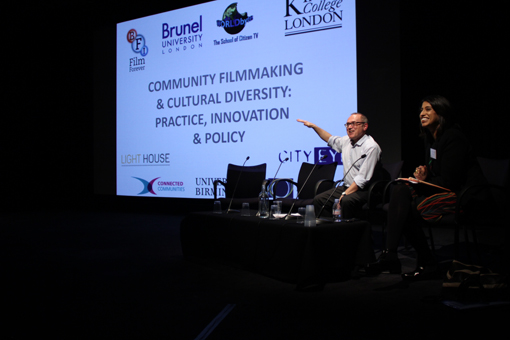Spotlight on Community Filmmaking
Conference Report
Drawing in delegates from a range of countries, including Spain, New Zealand and the USA, the international dimension of the project ensured that the themes around community filmmaking practice and diversity were discussed at both the local and global level.
Professor Yudhishthir Raj Isar from the American University of Paris and author of the United Nations Creative Economy Report 2013 opened the conference. In his opening keynote, entitled “Community cultural expression and human development in a global perspective”, he offered a critical view on the narrow perspective that has allowed the creative economy discourse to be imposed from the Global North to the Global South. Against this sterile policy transfer, Professor Isar used examples from community filmmaking project in South America and India to highlight the value of locality and local stories. He concluded that the cultural economy should not be seen as a highway but a collection of complex multiple trajectories, which are situated and path dependent.
Isar’s powerful presentation was followed by the parallel sessions that took place in the buzzy surround of the BFI. The first panel session in NFT3 focused on the themes of ‘Film and Cultural Diversity’ which were skilfully elucidated by Daniel Ashton from Bath Spa University in his talk on how amateur filmmaking meets the quality discourse in the BBC’s Life in a Day and Britain in a Day. Marion Vartaftig from the long-established community filmmaking organisation, Manifesta, talked about how the collective has enabled forms of diverse social expression through participative filmmaking both in the UK and Paris. And finally Marta Rabikowska and Matthew Hawkins from the University of Hertfordshire and Coventry University respectively, suggested that the creative act of filmmaking was a social act and highlighted how this has informed their own research process.
Meanwhile in the Blue Room the ‘Generation and Media Participation’ session started with Edward Webb-Ingall, a writer and filmmaker, presented the case study of the community filmmaking project ‘Reframed Youth’ with a self-identified LGBTQ group of young people. Alicia Blum-Ross from the London School of Economics critically reflected on the involvement of adults in youth film community projects, as intermediaries and often leaders or facilitators. The final paper of the session by Ryan Shand from the University of Glasgow commented on the amateur documentary film Escape to Freedom (Coleman/Lanark Cine Club, 1981) and its role presenting children within the historical context of Vietnamese refugees in Scotland.

David Buckingham’s keynote after lunch linked his own extensive research on amateur media with the matter of community cinema. The esteemed Loughborough University Professor provided a ‘critique of the euphoria’ that has materialised with the notion that the masses are now taking charge of the media. Buckingham offered instead ‘a defence of banality’, including ‘banal filmmaking’ and the role of emotion, subjectivity, memory and coherence behind and in from of the camera.
In the ‘Practices, production and innovation’ presentations in NFT3, three papers explored different aspects of community film making process and their challenges. Eileen Leahy from Trinity College, Dublin talked about community film response to the disappearing social housing estates in Ireland. Daniel Mutibwa from Leeds University in an ethnographic study of social documentary film making in Britain and Germany over the period 2009-2011, brought to the fore the way filmmakers navigate the dilemma of producing such documentary films for mainstream broadcasters. Finally, Mark Dunford from the University of Brighton and Digitales, discussed various public funded digital storytelling projects in which he has been involved.
 Learning on Screen
Learning on Screen